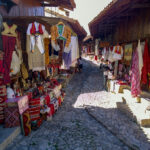In this blog post, we embark on a captivating linguistic journey to explore the beauty and richness of the Albanian language.
As one of the oldest languages in the Balkans, the Albanian language holds a unique position in the world of linguistics.
From its ancient roots to its modern-day expression, we will delve into the fascinating aspects of this vibrant language that embodies the spirit of Albania’s rich cultural heritage.
The Ancient Origins of the Albanian Language
The roots of the Albanian language trace back to the ancient Illyrians, an Indo-European people who inhabited the Balkans long before the Roman Empire. Although the exact origins of the Illyrian language remain shrouded in mystery, historical evidence suggests that it significantly influenced the development of modern Albanian.
The researchers agree on only one point that Albanian is a separate branch of Indo-European languages without relation to latin, germanic, slavic or any other big languages family.
This makes it very exciting for researches to study, considering that the country has few population and understand that how such a language managed to survive through time.
The Illyrians left behind only a few inscriptions and fragments of their language, making it difficult for linguists to decipher the entire language.
It is widely accepted that the Albanian language is the only surviving descendant of the Illyrian linguistic group. The preservation of elements from this ancient era is a testament to the resilience of the Albanian people and their language.
The Uniqueness of the Albanian Language
Albanian stands out among the world’s languages due to its remarkable preservation of ancient features. Linguists consider Albanian to be a distinct branch of the Indo-European family, separated from other languages for over two millennia.
The language’s isolation contributed to the preservation of archaic elements, making it a treasure trove for researchers and language enthusiasts.
One of the most fascinating aspects of the Albanian language is its rich vocabulary. It contains a substantial number of words with no known cognates in other Indo-European languages, indicating its unique development.
Additionally, Albanian has retained a considerable number of words from the ancient Illyrian, Latin, and Greek, adding further layers of complexity and historical significance to its lexicon. Some examples are “tenxhere” – pot, “tamam” – exactly from Turkish.
Gheg and Tosk: Dialectal Diversity of the Albanian Language
Albanian is characterized by two major dialects: Gheg and Tosk.
The Gheg dialect is primarily spoken in northern Albania and Kosovo, while the Tosk dialect is prevalent in southern Albania. Despite some differences, both dialects share a common linguistic core, and speakers from different regions can understand each other with ease.
The dialectal diversity of Albanian is not limited to its geographical distribution. Within each dialect, there are also local variations, which reflect the rich cultural heritage of different communities across the country.
You can find below some examples that show the different dialects:
| Standard language | English | Tosk | Gheg |
|---|---|---|---|
| ftua | quince | ftua | ftu(e) |
| një | one | një | nji / njâ |
| nëntë | nine | nëntë | nont/nândë |
| është | is | është | o / osht / âsht / â |
| bëri | did | bëri | boni/bani |
| emër | name | emër | êmën |
| vatër | fire pit | vatër | votër |
| gjendje | state | gjëndje | gjenje/gjêndje |
| mund | can | mund | mun |
| mbret | king | mbret | mret |
The impression of native Albanians is that the Gheg dialect sounds more manly, harsh and powerful.
It is related to the fact that these regions lived since long in mountains and fought many enemies trying to conquer Albania. The discussion is still ongoing between researchers about what dialect can be attributes to the original one.
This linguistic diversity fosters a sense of regional identity and pride among Albanians while maintaining the cohesive bond of a shared national language.
The Albanian Alphabet: A Unique Script
Albanian boasts its own unique script called the “Albanian alphabet.” This writing system, also known as the “Bashkimi” script, was created in the mid-19th century by scholars and intellectuals led by Naum Veqilharxhi.
The Albaniam language was written using various scripts like Greek and Cyrillic alphabets before the adoption of the Latin-based script.
The Albanian alphabet consists of 36 letters and is phonetic, meaning that each letter corresponds to a specific sound. This straightforward correspondence between letters and sounds makes Albanian relatively easy to learn and read. The script’s adoption was a significant step in promoting national identity and literacy among the Albanian people. It allowed them to express their language and culture in a standardised and accessible form.
Conclusion
The Albanian language is a treasure trove of history, culture, and linguistic uniqueness. Its ancient origins as a descendant of the Illyrian language, combined with its remarkable preservation of archaic features, make it a subject of fascination and admiration among linguists and language enthusiasts.
The dialectal diversity and the creation of the unique Albanian alphabet further contribute to the richness and complexity of this vibrant language, reflecting the diverse cultural tapestry of Albania.
The Albanian language stands as a testament to the resilience and cultural identity of the Albanian people.

